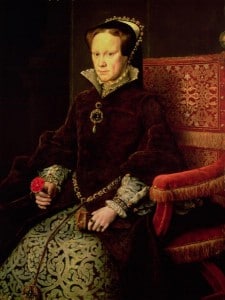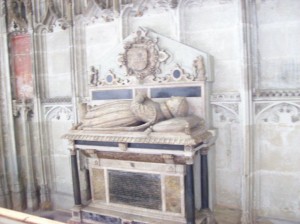 On 19th July 1553, thirteen days after the death of her half-brother, Edward VI, Mary was proclaimed Queen in place of Queen Jane.
On 19th July 1553, thirteen days after the death of her half-brother, Edward VI, Mary was proclaimed Queen in place of Queen Jane.
The Earls of Pembroke and Arundel had called a council meeting the previous day to convince council members that Mary’s claim to the throne was legitimate, but it was on this day in 1553 that they managed to convince the remaining privy councillors to switch sides from Jane to Mary. Their strategy was not just gentle persuasion, Pembroke actually drew his sword and cried, “If the arguments of my lord Arundel do not persuade you, this sword shall make Mary queen, or I will die in her quarrel.” Of course, everyone agreed with his arguments.
Pembroke announced Mary’s accession to the people of London that afternoon:
“The xix. day of the same monyth, [which] was sent Margarettes evyne, at iiij. of clocke at after-none was proclamyd lady Ma[ry to] be qwene of Ynglond at the crose in Cheppe with the erle of Shrewsbery, the earle [of Arundel], the erle of Pembroke, with the mayer of London, and dyvers other lordes, and many of the ald[dermen] and the kynges schrffe master Garrand, with dyvers haroldes and trompettes. And from thens cam to Powlles alle, and there the qwere sange Te Deum with the organs goynge, with the belles ryngynge, the most parte alle [London], and that same nyght had the [most] parte of London Te Deum, with bone-fyers in every strete in London, with good chere at every bone [fyer], the belles ryngynge in every parych cherch, and for the most parte alle nyght tyll the nexte daye to none.”
It seems that London was happy with the news.
Back at the Tower of London, Lady Jane Grey’s father, the Duke of Suffolk, interrupted his daughter’s evening meal to inform her that she was no longer Queen. Her canopy of state was taken down and Lady Jane Grey turned from Queen to prisoner, Queen to traitor. Her reign was over, and she would go down in history as “the Nine Day Queen”, although officially she reigned for thirteen days.
Mary didn’t actually know that she had been proclaimed Queen at this point. She found out the next day when William Paget and the Earl of Arundel arrived at Framlingham with the news.
(Taken from “On This Day in Tudor History” by Claire Ridgway)
Also on this day in history…
- 1543 – Death of Mary Stafford (née Boleyn), other married name Carey. It is not known where she was buried and there is also controversy regarding her date of death.
- 1545 – Henry VIII’s flagship, the Mary Rose, sank right in front of his eyes in the Battle of the Solent between the English and French fleets. Read more at 19 July 1545 – The Sinking of the Mary Rose.
- 1584 – Death of three year-old Robert Dudley, Baron Denbigh, son of Robert Dudley, Earl of Leicester, and his wife, Lettice, at Wanstead. He was laid to rest in the Beauchamp Chapel of St Mary’s Church, Warwick, and his tomb pays tribute to “the noble imp”.

Requesting a multi pronged “Correct me if I am wrong,” here, Claire:
1. Pembroke was long associated with the Tudors, wasn’t it?
2. Jasper Tudor, (Henry VII’s Uncle) if I am not mistaken, was Earl (or other title, I don’t recall) of Pembroke, correct?
3. Is this the same Pembroke of which Anne Boleyn was made Marchioness in her own right?
So it would make sense, the Anne Boleyn connection aside, for Pembroke to declare for Mary’s right of succession, seeing as she had a more direct line of descent from the Tudor relations who had held the title (were still holding, however indirectly?) historically.
The day of the ‘3 Marys’….
A happy and glorious one for Mary Tudor,
An unhappy and sad one for Mary Stafford (Boleyn),
and an unlucky, devastating one for the Mary Rose…
It is such a pity we don’t know where Mary Stafford was laid to rest, do you think there was a remote chance that she may have been taken to Lambert Church where her mother was buried, with the other Howards, or was she, perhaps, by this time a too poor and disgraced a relation for the Howard’s to be bothered with.
I wonder if Henry was told, he did seem to care for Mary. Did she died at Rochford Hall??, was there a church close by for her to be buried at…lost history is so frustrating.
Not a good day for Jane Grey either, or the poor wee ‘Noble Imp’.
Plus we ought to remember all those lives lost on the Mary Rose when she sank. Those poor men and boys, how awful…
Quite a sad day today in Tudor history isn’t it.
The council really had little choice but to see sense and declare Mary as Queen. She was gaining support and she would soon have an army. Her old counsellor the Duke of Norfolk was 70 when he led the army to uphold Mary as the true Queen. It was also ironic that it was the old Framlington Castle in Norfolk now belonging to Mary that she was coming to in order to rally her support. She did not know that she had been declared Queen, but as she moved towards London it must have given her faith and courage that her people began to gather and uphold her as the daughter of Henry and Katherine of Aragon in order to claim her as their Queen. And Elizabeth was at her side and they both were welcomed by the people in London.
Mary was actually generous at this stage to Jane Grey and her father. Frances Grey, her cousin was her friend and they remained close. As the daughter of Princess Mary Rose Tudor and Charles Brandon, she had known Mary all of her life and she was able to remain in favour. Henry her husband was also pardoned, but Jane was kept in the Tower, with her husband at least for now. It was only six months later when there was a second rebellion by Dorset, Suffolk and Northumberland, Jane’s father in law, that she gave in to the advic of her council and had them executed. She again pardoned Frances.
People today forget that Mary Tudor was very popular. She grew up being popular with the people and especially in the north she remained popular. She was a Tudor and her father’s daughter: Jane was not known. Mary was named to follow Edward by her father’s will and an Act of Parliament in 1544. Jane was next after all of them; not meant to skip them all. She was chosen as the favourite Protestant heir but that did not make her the valid claimant to the throne. Her parents promoted her claim, but by passed Mary and Elizabeth, making Jane Queen instead. 10 days later they came to their senses, had no choice but to accept mary as the true Queen and had they played their cards right then they would have found favour in the new reign. Mary was geneous to her enemies. She was not generous to heretical traitors like Cranmer, but to those who tried to steal her crown, she was very generous. Had she came to the throne as a younger woman and had a child I think she would have made a better Queen even than Elizabeth.
The nightmare is over and the true Queen is finally Queen to popular acclaim, not silence, as with Jane Grey. Long live Queen Mary Tudor. Welcome.
I do think of Mary as an unhappy human being ! Unhappy in her childhood ,being separated from her mother whom she very probably loved deeply…….being unsure all the time of her father’s feeling for her ……marrying a man who clearly did not love her ….Philip II of Spain was certainly a political man who did not care for Mary at all……unhappy at not being able to have a child …..and unhappy about her ” cruelty ” to protestants having inherited from her spanish mother and grandparents Isabel La Catolica and Fernando de Aragon their views of oppression for people who were not fanatical catholics …….but to cause such horrible deaths must surely have been a source for a troubled mind ……
Very good summary, very good insight. Yes, I agree.
Mary was proclaimed Queen and the people went wild.
Jane was proclaimed Queen and the people were silent. Kinda speaks for itself.
Mary was the Tudor Queen the people wanted and the law recognised, the true born daughter of Henry Viii and Katherine of Aragon and yet she had to fight for her rightful throne because her kid brother wrote her out of the succession. In her stead he chose her sixteen year old cousin, Lady Jane Grey, the granddaughter of King Henry’s sister, Princess Mary. His daughter was restored to the succession in 1544. Now after thirteen days Jane was no longer Queen as the Council and navy and authority changed sides to support Mary after she rode to East Anglia to raise support. Now she was Queen and Jane was abandoned by her parents.
Mary pardoned most people involved in the plot against her but Jane and her husband and his brothers and Thomas Cranmer were all put on trial for treason. The brothers, all but Guildford Dudley were found not guilty but Jane and he were as was Cranmer. Mary saw Jane as almost a pawn and there is evidence that she hoped to pardon and release her but her father got himself into the Wyatt plot to remove and kill Mary in favour of Elizabeth. It was obvious that Jane was dangerous by de fault and could be used by enemies to remove Mary and under pressure and probably because the Realm would never be safe as long as this Protestant figurehead remained alive. The Spanish hinted that Mary should execute her and as she was already condemned, it was merely a case of carrying out her lawful death sentence. Mary, with reluctance, agreed.
Mary’s reintroduction of the heresy laws were popular and expected. She was involved in very few of the locally prosecuted trials in her reign and in fact was more merciful than most monarchs of her time.